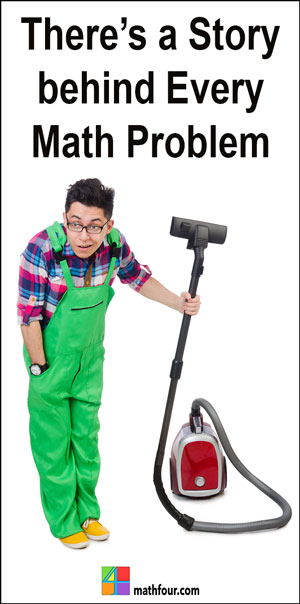 If it’s a (real) math problem, it has a story.
If it’s a (real) math problem, it has a story.
Have you ever done a math problem, outside of a math class or a puzzle book, that didn’t have a story behind it?
Probably not.
And yet, we ask our children every day to work math problems without giving them the story behind the problem.
There are 3 Reasons to Do Anything
Everything you do is done for utility, entertainment, or education.
When I fold clothes, I do it for utility. They’re clean, they’re dry, and eventually they have to be put away. So I need to fold them.
When my mother-in-law visits, she always asks if I have laundry that she can fold. I’ve never asked, but I suspect that she folds clothes for entertainment.
When my daughter folds clothes, it’s neither for entertainment nor for utility. It’s for her education. She has to learn how to fold so later she can fold for utility or entertainment.
I will have her fold five napkins as an exercise, and then finish the basket myself.
I will not, however, ask her to fold a napkin into an origami crane. There’s no reason she would ever need to do this, outside of entertainment.
And if she wants to fold origami crane napkins, she can find someone else to teach her.
There are 3 Reasons to Do Math
Math, also, is done for utility, entertainment, or education.
And like laundry, the education of math is (or should be) about helping students to learn the utility of math.
Which means using math for a purpose. Not making origami cranes!
In short:
When learning, practice with exercises that closely match reality.
Don’t use exercises that barely connect to reality.
Create a Story to Clarify the Math Problem
A reader commented on a post about combinations and permutations:
This is really helpful but there’s still [a] question in my book that’s been bugging me.
(Permutation) How many ways can a teacher select 6 students from a class of 30 to clean the room?
I thought, “Why would this be a permutation?”
The story behind the problem was missing!
A Story for Permutation
Math Problem: How many ways can a teacher select 6 students from a class of 30 to clean the room?
- Back of the book answer option 1: Permutation with 427,518,000 ways
The Story: Mrs. Crowder is sick of cleaning the classroom herself. Especially since her students are the messiest she’s seen in 20 years of teaching. One afternoon she freaks out and says, “I’m done! I’m using the name hat to assign cleaning jobs.”
Mrs. Crowder writes down six jobs on the board:
- Vacuum
- Clean Counters
- Wash Boards
- Arrange Desks
- Neaten Front Shelves
- Neaten Back Shelves
The crazed Mrs. Crowder, before she starts drawing names, says, “You might get out of doing something today, but we’ll do this every day. By the end of the school year, each of you will do each job at least once.”
But she’s wrong. Not every student will have each job at some time during the year. How do you convince Mrs. Crowder that she’s wrong. (Assume she’s calmed down and thinking rationally when you talk to her about this.)
Story for Combination
Same Math Problem: How many ways can a teacher select 6 students from a class of 30 to clean the room?
- Back of the book answer option 2: Combination with 593,775 ways
The Story: Mrs. Devine knows that students build better character if they care for their own space. She starts the school year saying, “We’ll use the name hat to choose six students at the end of each day to neaten the room.”
She gives them a list of six things to be done and says, “I don’t care who does what, the six people can decide among themselves. As long as all the tasks are done by the six person team.”
She then says to the class, “There are 183 class days, and there are about 250 different ways to get the six man team. So some of you won’t have to do it as much as others. But that’s just the way life goes.”
You suspect that there are more than 250 different six man teams and want to show Mrs. Devine how smart you are. (After all, you kinda have a crush on her.) What do you do to convince her?
What’s Your Story?
Or what’s your math problem?
The next time you do a math problem, put a story to it. Does it help?
Share your experience in the comments, on Twitter, Facebook or Pinterest!

You might also like:
- Permutations and Combinations – How to Tell the Difference
- How to Pronounce n! and How to Use Factorials
- Permutations in Braiding Hair
- How to Calculate Permutations and Combinations
This post may contain affiliate links. When you use them, you support us so we can continue to provide free content!






